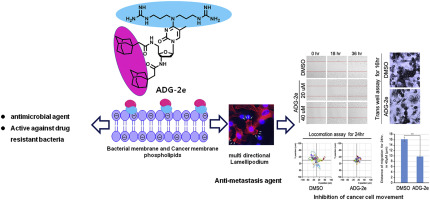European Journal of Medicinal Chemistry ( IF 6.7 ) Pub Date : 2020-03-19 , DOI: 10.1016/j.ejmech.2020.112233 Sridhar Chirumarry , Nak-Kyun Soung , Junyeol Han , Eun Young Kim , Eun Kyoung Ryu , Young-Ho Lee , Song Yub Shin , Pethaiah Gunasekaran , Jeong Kyu Bang

|
Antimicrobial peptides (AMP) with anticancer activity have drawn remarkable attention in modern treatments. However, long peptide length and protease instability are the most addressing factors, which hampers their further development as therapeutic agents. In view of this, herein, we designed and synthesized a series of AZT-based cationic small molecule incorporating a variety of hydrophobic groups and cationic charges, including amine and guanidine groups to mimic the amphipathic structure of AMPs. These compounds were evaluated for their antibacterial activity against Gram-positive and Gram-negative bacteria. Through an extensive structure activity relationship study (SAR), we identified ADG-2e as the most potent antibacterial agent, which exhibited remarkable potency against drug resistant bacterial strains such as MRSA and MDRPA. Further, ADG-2e was examined for their anti-metastatic ability by investigating the cancer cell migration and invasiveness through scratch wound-healing assay and transwell invasive assay, respectively. In addition, time-lapse cell tracking analysis also performed for analyzing the cell movement pattern. Treatment of ADG-2e against metastatic breast cancer cells (MDA-MB-231) suppressed tumor cell migration by multi-directional lamellipodium formation, indicating their anti-metastatic potential. Thus, our cationic AZT based small molecules may evolve as an appealing class of antibacterial agents with anti-metastasis potential.
中文翻译:

抗菌AZT衍生物可调节乳腺癌细胞的转移
具有抗癌活性的抗菌肽(AMP)在现代治疗中引起了极大的关注。然而,长肽长度和蛋白酶不稳定性是最解决的因素,这阻碍了它们作为治疗剂的进一步发展。鉴于此,我们在本文中设计并合成了一系列基于AZT的阳离子小分子,这些小分子结合了各种疏水基团和阳离子电荷,包括胺基和胍基基团,以模仿AMPs的两亲结构。评价这些化合物对革兰氏阳性和革兰氏阴性细菌的抗菌活性。通过广泛的结构活性关系研究(SAR),我们确定ADG-2e是最有效的抗菌剂,它对MRSA和MDRPA等耐药细菌菌株表现出显着的效力。进一步,通过分别通过划痕伤口愈合测定法和transwell侵入性测定法调查癌细胞的迁移和侵袭性,检查了ADG-2e的抗转移能力。此外,还进行了延时细胞跟踪分析,以分析细胞运动模式。针对转移性乳腺癌细胞(MDA-MB-231)的ADG-2e治疗可通过多方向薄层脂质体形成抑制肿瘤细胞迁移,表明其抗转移潜力。因此,我们基于阳离子AZT的小分子可能会演变成具有抗转移潜力的一类有吸引力的抗菌剂。延时细胞跟踪分析还用于分析细胞运动模式。针对转移性乳腺癌细胞(MDA-MB-231)的ADG-2e治疗可通过多方向片状脂质体形成抑制肿瘤细胞迁移,表明其抗转移潜力。因此,我们基于阳离子AZT的小分子可能会演变成具有抗转移潜力的一类有吸引力的抗菌剂。延时细胞跟踪分析还用于分析细胞运动模式。针对转移性乳腺癌细胞(MDA-MB-231)的ADG-2e治疗可通过多方向薄层脂质体形成抑制肿瘤细胞迁移,表明其抗转移潜力。因此,我们基于阳离子AZT的小分子可能会演变成具有抗转移潜力的一类有吸引力的抗菌剂。


























 京公网安备 11010802027423号
京公网安备 11010802027423号